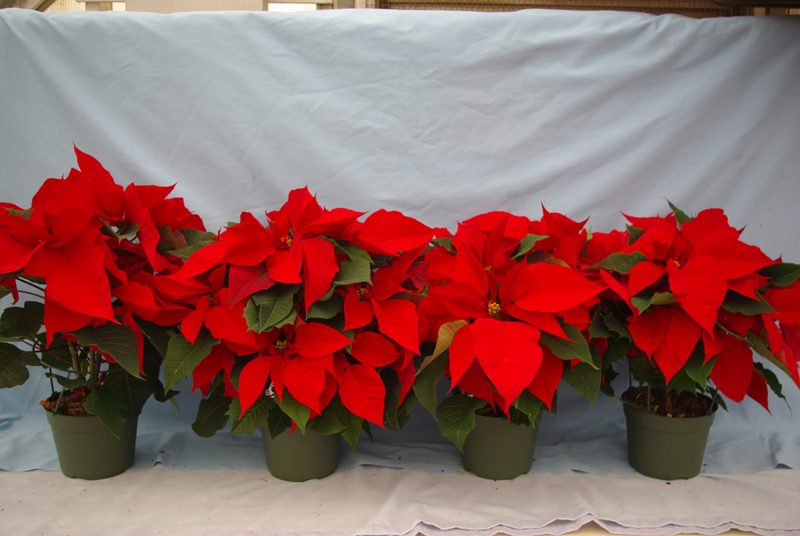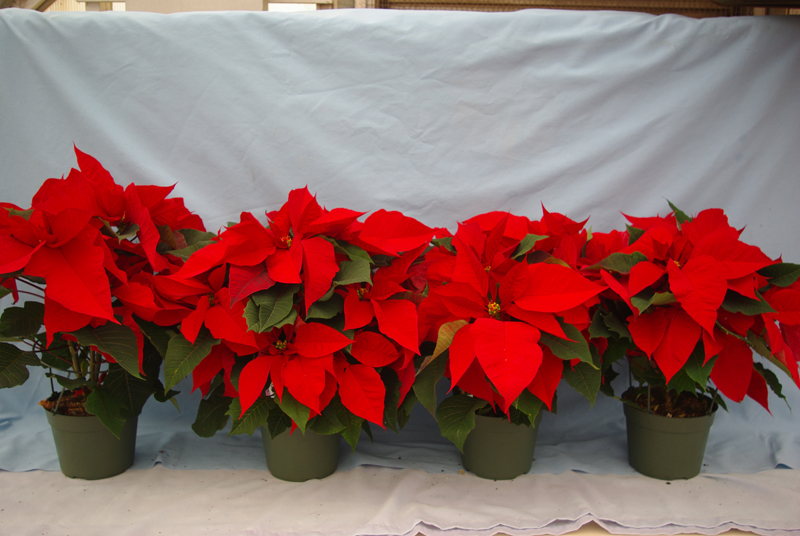
Production Studies from the North American Poinsettia Trials
Along with the evaluation of the new cultivars at the trial sites, several experiments are conducted to study different production issues. Below are reports on four of these trials. These trials are supported by the poinsettia breeder and marketing companies.
Augeo Chemical Pinch
North Carolina State University (NCSU)repeated its Augeo experiment on five of the same cultivars as last year (Jubilee, Noel, Prestige, Prima and Stargazer) and on one new cultivar (Neva). NCSU applied 800 or 1,600 ppm once 10 days after transplanting or 800 ppm twice (second application seven days after the first). Pinched plants without Augeo were included. Data collected included plant height, diameter, number of shoots and dominant bract clusters, fresh and dry weight, and days to first color, visible bud and anthesis.
As with last year Augeo produced well-branched plants that looked great at the time of flowering, depending on the application rate (Figures 1 and 2). The tallest plants were those treated with only 800 ppm once, showing the lack of control of the main stem. The shortest plants were generally those treated with 800-ppm Augeo twice. Augeo greatly increased number of shoots, but most of those shoots remained below the canopy and only one or two bract clusters more were visible for most cultivars compared to pinched plants.
This experiment shows why researchers generally repeat experiments — last year Augeo had little effect on timing. Not so this year. All of the cultivars were delayed by Augeo treatment. The most affected was Neva (Graph 1) with 1,600 ppm delaying first color by seven days, visible bud by 10 days and anthesis by 20 days. The least affected was Prestige (Graph 2) with 1,600 ppm delaying first color by one and a half days, visible bud by five days and anthesis by eight days.
In summary, 800 ppm worked well for Noel and Prima, while 1,600 ppm worked best for Jubilee, Neva, Prestige and Stargazer. For none of the cultivars was 800 ppm applied twice the best treatment. Timing can be greatly delayed but is variable, with some cultivars more affected than others.
Media Evaluation for Root Growth
At NCSU, we have never been pleased with the root development on our poinsettias. This year we tested four substrates to find one that would produce a better root system. We focused on the effect of bark in the mix, so we grew Alreddy Red, Bravo Bright Red, Christmas Day, Early Mars Red and Tikal Red with Oldcastle Custom Mix with or without bark, Pro-Mix BX (without bark) or Fafard 4p (with bark). All four substrates produced quality top growth and there was little difference in plant height or diameter (Figures 3a and 3b). Root growth varied quite a bit with the cultivar and substrate. Oldcastle Custom Mix without bark gave the best results for Bravo Bright Red and Early Mars Red (Figure 4). Alreddy Red roots were the best in either substrate without bark. On the other hand, Fafard 4P (with bark) was the best for Christmas Day and substrate didn’t make much difference for Tikal. Overall, it appears that substrates without bark might enhance poinsettia root growth; certainly growers should conduct tests on their crops. Evaluation of Late Flowering Varieties in Warm Climates In warm climates where it may be difficult to hold mature plants in the greenhouse, growers can have difficulty with varieties for the late markets after Dec. 10. At the University of Florida, we selected from the variety trial the latest varieties based on the breeder’s description of timing. Some of the varieties used are not positioned for the late market by the breeder, but were the latest they had in the trials. Rooted cuttings were planted on Aug. 19 or 20 and grown in 6.5-inch containers. All were pinched on Sept. 3 and kept under natural days. Bonzi drenches were used as needed to produce plants 16-18 inches. Micro drenches at 0.1 to 0.2 ppm were used until Oct. 31 and a late drench of 1.0 ppm was applied in early November if needed. On Dec. 12, plants were rated for overall appearance. Ratings and comments on each variety are shown in the table above. Prestige Red is often used as the late variety for many growers; however, it will finish too early in some years as it did in 2013. The clear best red variety in this trial was Neva, which is relatively new from Syngenta and not too many growers have tried it. The plants finished at 18 inches with three micro drenches and a late drench. Neva is versatile and has enough vigor and stem strength to make nice larger plants. For colors and novelty varieties, Red Glitter and Burgundy were good, but the demand for these is not very strong in the late market. Whites are more important, and the best late white is now Glace. Glace is vigorous and PGR use is important — see the following study. Glace Height Control in Florida Glace is an important new variety (see Table 1) because of the quality of the bract color. Glace is vigorous, but has better stem strength than Snowcap and can be used for large formats. This trial evaluated different PGR applications for Glace height control as shown in the table. Rooted cuttings were planted on Aug. 22 and pinched on Sept. 6. The plants were grown under natural days. The best height control came from two sprays of B-Nine and Cycocel tank mix at the medium rate of 1,500/1,250 ppm, which is treatment No. 2. Plants in treatments 4 through 6 were given a low (1,000 each) B-Nine and Cycocel spray early and then a Bonzi late drench at different rates on Nov. 7. These treatments provided good control as shown in the picture. Interestingly, the treatment that did not work very well was the use of only Bonzi drench applications. The plants in treatment 3 were given four early drenches at 0.1 ppm and a late drench at 1.0 ppm. For early control, Glace appears to be much more sensitive to a B-Nine and Cycocel spray than to Bonzi drench. If the micro drench is to be used, try higher rates of 0.2 ppm. Find out how poinsettia cultivars performed in various production trials



 Video Library
Video Library 




















